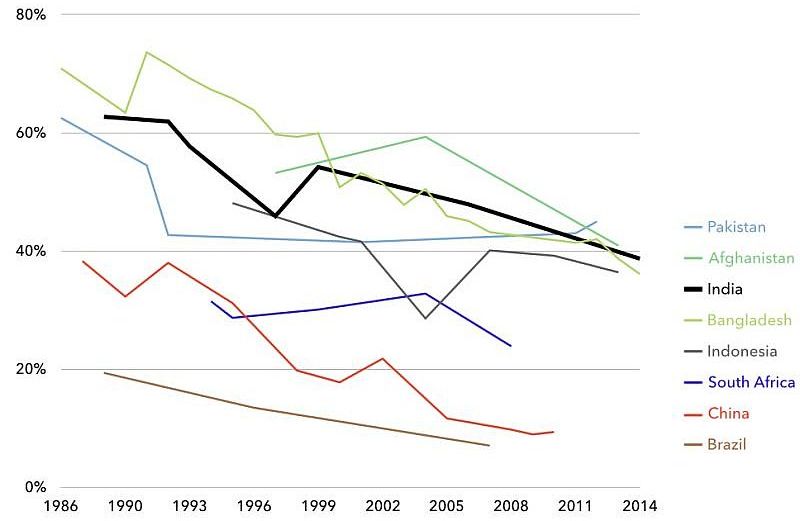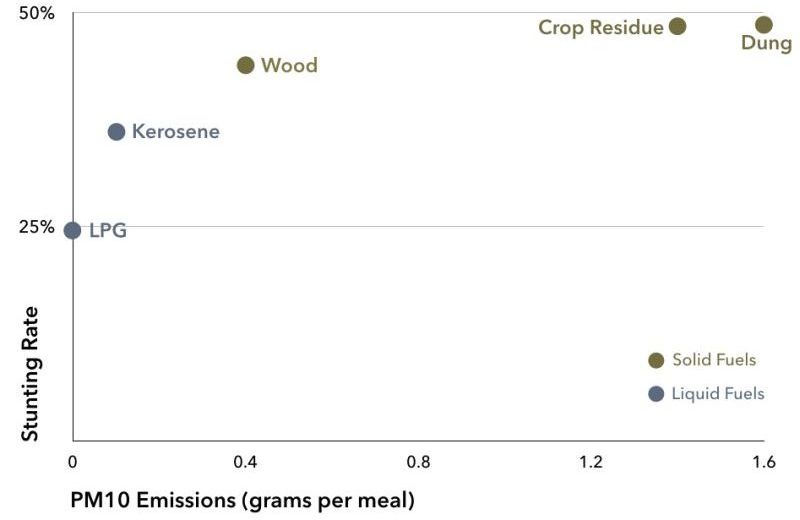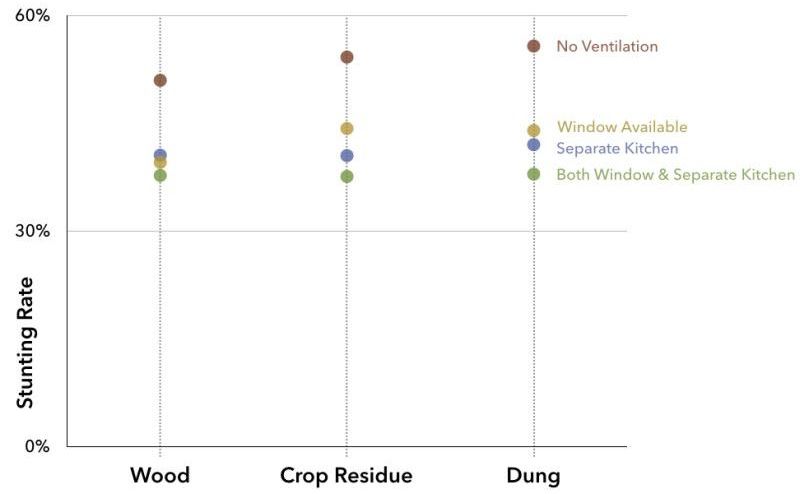While the conversation on air quality has been focussed largely on outdoor air pollution, millions of deaths occur due to indoor air pollution as well. Based on 2005–2006 National Family Health Survey data, this column presents strong evidence that exposure to indoor air pollution from burning solid fuels increases the probability of stunting among children in India.
4.3 million people worldwide die each year due to indoor air pollution. The conversation on air quality, however, has been focussed largely on outdoor air pollution. Our analysis of 2005–2006 National Family Health Survey (NFHS-3) data finds strong evidence that the exposure to indoor air pollution from burning solid fuels increases the probability of stunting among children in India (IIPS (International Institute for Population Sciences), 2007).
Stunting is big in India
A child is regarded as stunted if her height-for-age is below certain thresholds set as per the WHO (World Health Organization) Child Growth Standards. Stunted children tend to have both physical and cognitive developmental delays, including delayed walking, impeded speech development, and diminished school performance (Hoddinott et al. 2013). They also experience higher rates of mortality and morbidity, including diabetes and hypertension (McDonald et al. 2013).
According to NFHS-3 data, as many as 43% of Indian children under the age of five, were stunted as of 2006. Despite high economic growth during the last few decades, India still has the highest prevalence of stunting among all South Asian economies with the exception of war-stricken Afghanistan. The sheer magnitude of the problem is apparent in the fact that India has 61 million stunted children, more than any other country.
Figure 1.
 Note: Stunting rate is
Note: Stunting rate is Source: UNICEF (The United Nations Children's Fund)
The connection between stunting and solid cooking fuels
While stunting is most commonly associated with poor nutrition, there is an emerging body of research, Mishra (2007) and Machisa et al. (2013), that links it to exposure to poor air quality. In many households in India, solid fuels ¬− such as coal, wood, crop residue, and dung – are used for cooking. These fuels release particulate matter, carbon monoxide, formaldehyde and other toxins, at a much higher rate than non-solid fuels such as kerosene and LPG (liquefied petroleum gas). Children’s lungs are still developing and are therefore particularly susceptible to irritation and contamination from the fumes of solid cooking fuels; when children’s bodies must repeatedly fight off the respiratory infections these fumes provoke, their growth suffers.
Figure 2. The association between fuel used for cooking and stunting rates among children in India
We analysed NFHS-3 data to identify the main drivers of stunting among Indian children. Controlling for nutrition, recent illnesses, and other socioeconomic factors, living in a household that
Breaking the link between indoor air pollution and childhood stunting
In May 2016, the Indian government began providing below-poverty-line households with LPG connections. At the same time, many NGOs and local institutions are working to replace traditional cookstoves with more efficient ones, which would reduce the total quantity of fuel consumed and emissions produced per hour of usage.
Although a transition to cleaner fuels and technology is perhaps the only long-term solution that addresses the indoor air pollution problem at its roots, we find that there is a second option that has the potential to tackle stunting. Having appropriate ventilation mechanisms can considerably mitigate the negative impact of solid fuel smoke exposure on child stunting. The simple presence of a window in households burning solid fuels is associated with a 3.4% lower prevalence of stunting. Having separate kitchen and living areas reduces the chance of stunting by 4%. As the data capture only whether households possess the different ventilation options and not their actual usage, so the benefits of using ventilation consistently and strategically are probably greater.
Figure 3. Child stunting rates by type of fuel used in households & ventilation
In order to be free of the health risks associated with air pollution, citizens need clean air both at home and in their communities. A permanent transition to cleaner fuels is perhaps the only solution that will improve India’s air quality − both indoors and outdoors. In the meantime, low-cost ventilation solutions have the potential to mitigate the impact of solid fuel burning on
This article first appeared in Hindustan Times. It is based on a study undertaken in collaboration with Dr Souvik Datta of Glasgow University.
Further Reading
- Hoddinott, John, Harold Alderman, Jere R Behrman, Lawrence Haddad, and Susan Horton (2013), “The economic rationale for investing in stunting reduction”, Maternal and Child Nutrition, 9: 69-82.
- International Institute for Population Sciences (IIPS) and Macro International (2007), ‘National Family Health Survey (NFHS-3), 2005–06: India’, Volume I, Mumbai.
- Mishra, Vinod and Robert D Retherford (2007), “Does biofuel smoke contribute to anaemia and stunting in early childhood?”, International Journal of Epidemiology, 36(1): 117-129.
- Machisa, Mercilene, Janine Wichmann and Peter S Nyasulu (2013), “Biomass fuel use for household cooking in Swaziland: Is there an association with anaemia and stunting in children aged 6–36 months?”, Transactions of The Royal Society of Tropical Medicine and Hygiene, 107(9):535–544.
- McDonald, Christine M, Ibironke Olofin, Seth Flaxman, Wafaie W Fawzi, Donna Spiegelman, Laura E Caulfield and Goodarz Danaei (2013), “The effect of multiple anthropometric deficits on child mortality: Meta-analysis of individual data in 10 prospective studies from developing countries.”, American Journal of Clinical Nutrition, 97(4), 896–901.
- Smith, Kirk R, Jonathan M Samet, Isabelle Romieu and Nigel Bruce (2000), “Indoor air pollution in developing countries and acute lower respiratory infections in children”, Thorax, 55(6):518-532.




 15 November, 2017
15 November, 2017 







Comments will be held for moderation. Your contact information will not be made public.